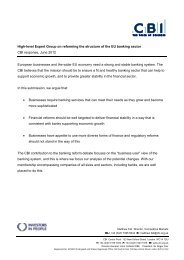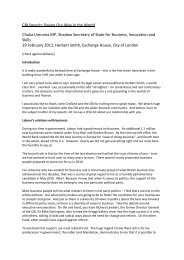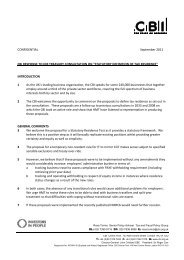Read the full policy brief (pdf) - CBI
Read the full policy brief (pdf) - CBI
Read the full policy brief (pdf) - CBI
Create successful ePaper yourself
Turn your PDF publications into a flip-book with our unique Google optimized e-Paper software.
negotiation and allow disputes to develop intostrikes.The partnership approach demonstrated during<strong>the</strong> recession across <strong>the</strong> private sector shouldnot, however, make us complacent. The publicsector was until 2009 largely immune from payfreezes and o<strong>the</strong>r testing changes in response totougher conditions. The previous governmenttended to back away from difficult employeerelations issues, such as reform of public sectorpension schemes.The new government has started to change that,for example by implementing a two-year payfreeze across <strong>the</strong> public sector as part ofrecognising <strong>the</strong> extent of <strong>the</strong> budgetarychallenge. But many unions seem reluctant toface up to this reality. At <strong>the</strong> 2010 TUC Congress,union leaders called for nationwide actionagainst spending and headcount cuts, with someeven urging a campaign of civil disobedience inprotest at <strong>the</strong> government’s essential work oftackling <strong>the</strong> deficit. This is particularly concerningfor <strong>the</strong> most vulnerable members of society, whodepend on reliable public services. It alsothreatens <strong>the</strong> hard-won reputation of <strong>the</strong> UK as agreat place to invest and create jobs.‘The growing risk of industrialaction makes it all <strong>the</strong> moretimely to update <strong>the</strong> legalframework.’None<strong>the</strong>less, <strong>the</strong> growing risk of industrial actionmakes it all <strong>the</strong> more timely to update <strong>the</strong> legalframework. Moreover, recently <strong>the</strong>re have beena number of high profile strikes which havecaused significant disruption to <strong>the</strong> generalpublic and businesses. Some of <strong>the</strong>se disputeshave raised questions about both <strong>the</strong> conduct ofcollective bargaining in <strong>the</strong> workplace of 2010and <strong>the</strong> appropriateness of aspects of labour lawrelating to trade unions.The regulatory framework around industrialaction was largely shaped in <strong>the</strong> 1980s. Just aslife in <strong>the</strong> workplace doesn’t stand still, <strong>the</strong>framework of industrial relations law too needsto be modernised.The <strong>CBI</strong> has developed a package of proposedreforms. Building on <strong>the</strong> proposals we releasedin June, <strong>the</strong> ideas below are not exhaustive: <strong>the</strong>yare intended to be a constructive, reasonablepackage which would bring <strong>the</strong> law up to dateand ensure a fairer balance. They have beendeveloped in consultation with <strong>CBI</strong> members in<strong>the</strong> light of <strong>the</strong>ir experience of industrial actionand key legal judgements since <strong>the</strong> last revisionof industrial relations law under <strong>the</strong> previousgovernment.Industrial action is not inevitable: if public sectoremployers, employees and unions adopt <strong>the</strong>positive approach we have seen in most of <strong>the</strong>private sector in response to economicpressures, necessary change can be achievedconstructively through discussion andnegotiation. This means managers must addressissues in <strong>the</strong> workplace head on and make <strong>the</strong>case for change, ra<strong>the</strong>r than shy away from
















